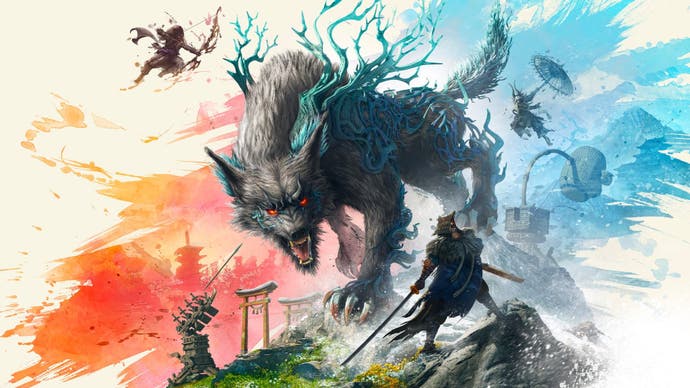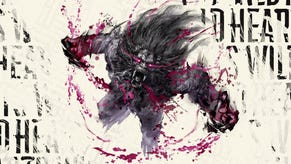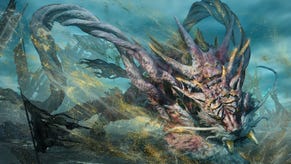Wild Hearts review - Monster Hunter's formula taken to fantastic new heights
Aorta play it.
Welcome to Azuma, a fantastical spin on feudal Japan where cherry blossoms dance playfully across shimmering waters beneath mountains of gold, where Kemono – behemoth creatures fused with the very essence of nature – roam free, and where anyone that's ever played a Monster Hunter game will feel immediately at home.
It never feels quite right to start a review by talking about another game, but in Wild Hearts' case it's pretty much unavoidable. It cribs so thoroughly from Capcom's long-running Monster Hunter series, it isn't just indebted to it, it simply wouldn't exist without it. But while the sense of déjà vu is strong at times, particularly early on, developer Omega Force's smart reimagining of a familiar formula propels Wild Hearts way past competent clone to become a wonderful experience in its own right.
Wild Hearts' core, though, will be immediately familiar to students of Capcom's series – or indeed any of its occasional imitators, including Omega Force's own Toukiden games – serving up a progression loop built around hunting ferocious mega-fauna again and again and again. Essentially, downed monsters drop parts used to craft stronger weapons and gear, and those in turn make it easier to bring down far more powerful foes, and on it goes. It's a system of more-ish acquisition – here loosely held together by a tale of ecological disruption more notable for its cast of surprisingly well-drawn characters than any particularly original plot beats – that's as compelling in Wild Hearts as it is anywhere else.
It's also inherently a system of delicate balance, requiring strong moment-to-moment action to avoid an easy slide into mind-numbing grind, and, thankfully, Wild Hearts delivers and then some. Chiefly, that's down to its stellar combat, which remains dizzyingly thrilling throughout its lengthy campaign, in large part due to smart decisions around revision and refinement that permeate much of the game, stripping the monster hunting genre down to its most interesting fundamentals, then building those back out with some compelling new twists of its own.
In combat, for instance, Monster Hunter's inherent fussiness has been traded for something slicker, more streamlined, and more responsive across its eight distinctive weapons. These range from a newcomer-friendly katana focused on light and heavy attacks to more exotic contraptions like a bladed parasol capable of parrying and a staff that's able to transform into five distinct forms. There's a real sense of clarity and focus across Wild Hearts' comparatively limited arsenal, and that applies to its somewhat slender, but wonderfully distinctive monster roster too. There are drop-kicking chickens, sap-spewing jackalopes, and stretchy limbed fire apes, right through to more majestic creatures like eagles and wolves – all sporting unique move sets that expand interestingly as more elemental variants are introduced during play.

In many ways, all this feels like a deliberate response to Monster Hunter's increasingly maximalist approach, Wild Hearts' numerous systemic tweaks trading friction and fuss for a greater sense of fluidity and freedom. I love, for instance, the way battles – and seamless co-op online play - can be initiated simply by selecting a target on the world map; I love the way you can eat any combination of foodstuffs at any time while out in the field to quickly tailor their temporary bonus-granting properties to your individual needs; or the way you're able to carry over your favourite skill boosts, slots allowing, when you move from one weapon to the next in the upgrade tree, or the video game-y simplicity of levelling up your tiny spherical companion - which assists during solo battles - by finding its friends out in the world.
And, oh, what a world it is. Towering Japanese fortresses rise up through the mists of snow-blasted valleys; abandoned villages slump onto riverbanks in the shadow of golden-hued mountains; charred battlegrounds spill out onto fields of dazzling red flowers into crystalline grottos; bamboo thickets fold into winding rock canyons before exploding out again onto endless vistas of undulating silvergrass. It's not perfect; there are perhaps just a few too many instances where cramped, overdesigned spaces frustratingly impede combat flow, but for the most part it's beautiful stuff – and even more impressive once rampaging Kemono start smashing it to bits.
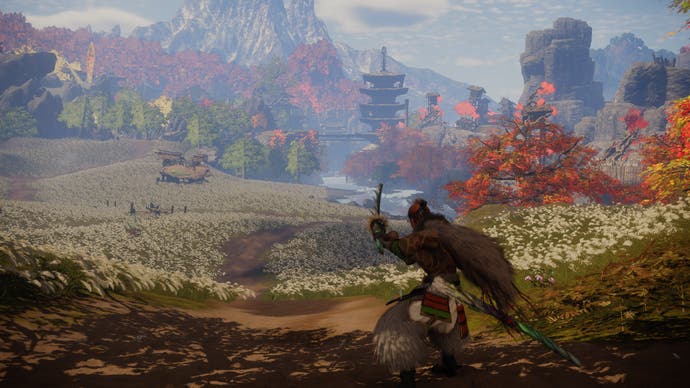
Crucially, though, Omega Force has created a wilderness waiting to be tamed. Rather brilliantly, its five discrete environmental expanses aren't mere backdrops for battle, but exist to be conquered and bent to your whims - and that's where the Karakuri system comes into play. Karakuri - intricate wooden contraptions that unfurl impossibly into an array of exotic devices for use in combat, traversal, or both – are ubiquitous in Wild Hearts, informing every inch of its action and giving its otherwise familiar monster hunting rhythms a vibrant character of their own.
Out of combat, players can – with some gradually diminishing limitations – construct Karakuri wherever and however they see fit, shaping Wild Hearts' labyrinthine wildernesses into highly personalised, persistent playgrounds. At the most basic level, that means you can establish a respawn camp anywhere that seems most strategically beneficial at any given time. You might choose to set down near an Ancient Tree that can be tapped for flasks of restorative Healing Water, or by a stream capable of supplying edible fish. But you can also take things further, building a forge to craft weapons and armour away from the hub town of Minato, or even a radar tower capable of highlighting the locations of target monsters and other items.
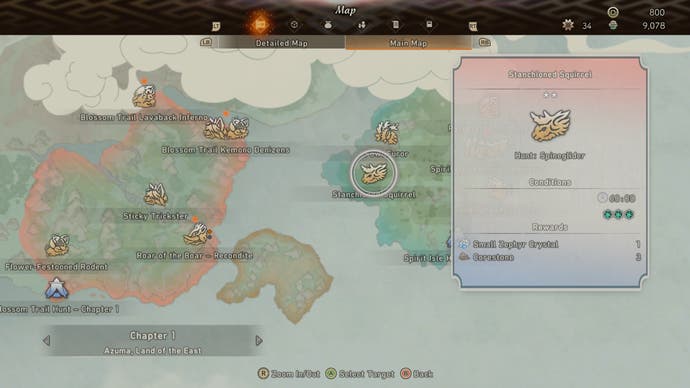
Things get much more exciting, though, as you begin to unlock traversal Karakuri; Wild Hearts' environments are cluttered, confusing, sometimes overwhelming sprawls – a characteristic they share with Monster Hunter World. But where Capcom's confounding efforts always felt like a design misstep (one since remedied in both Iceborne and Rise), here the chaos feels intentional - a wilderness waiting to be subdued with giant fans capable of blasting glider-wielding players straight up cliff sides, zip wires used to careen over massive distances in seconds, and more, all of which persist for other players as they hop in and out of your world.
It's a system of personalisation that really helps bring environments to life, and one that adds a pleasing preparatory rhythm to the action, where exploration and reconnaissance are near-essential upon arriving in any new corner of Azuma. Before you even consider taking on new Kemono, you'll almost certainly want to head out and prime the land, opening up new Dragon Pits to expand the amount of Karakuri you can place, tapping Ancient Trees to fully refill Healing Waters as needed, building shortcuts, strategically placing campgrounds, and so on. It all works brilliantly, and there's a real sense of symbiosis between the world, what you do in it, and how that impacts those all-important battles. Being aware there's an Ancient Tree right around the corner, for instance, can be a literal life saver during a fight, and it's hard not to feel smug when you cut a fleeing Kemono off at the pass thanks to a zip line you prepared earlier.
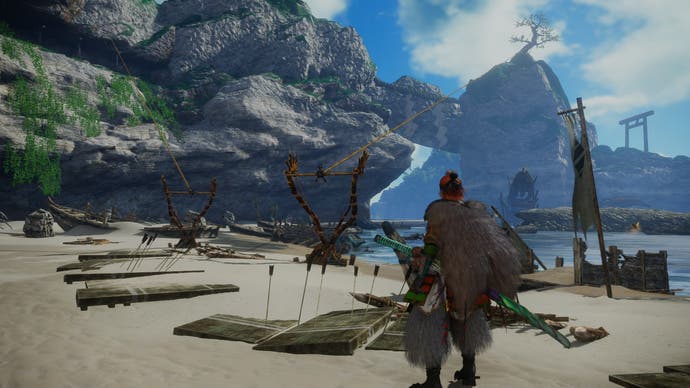
Of course, specific Karakuri also have a more explicit function during combat. You can build a spring to rapidly boing out of harm's way, stack crates to launch skyward and initiate an aerial attack, fire a grapple that, when used effectively, lets players dart around Kemono like a particularly annoying fly. That's only scratching the surface of Wild Hearts' expansive Karakuri unlock tree, but the crucial thing is how all this impacts the rhythms of battle, which – and I never dreamed I'd be making this comparison when I started playing - has something of Fortnite to its combat flow. Like that game, where familiar action suddenly lurches into the realm of furious multi-fingered construction to gain the upper hand, Wild Hearts has a similar vibe, and there's a similar sense of satisfaction from those 'I made this!' moments when, with a flurry of digits, something impossible springs into existence just in the nick of time.
Getting to grips with all this is, admittedly, a little fiddly at first, and more than a little fraught when you also have to worry about the 20-foot behemoth bearing down on you. But it's a hurdle worth overcoming, particularly as its more advanced Fusion Karakuri – basically, build combos that transform basic Karakuri into tide-turning mega-contraptions – are both essential to victory and immensely gratifying. Rapidly plop down six torches, for instance, and you'll create a firework capable of grounding anything in the air; combine a stack of crates to conjure a bulwark that'll send charging enemies into a devastating tailspin; then there are the likes of bombs, harpoons, and a spring-loaded mallet that, if timed correctly, can do some astronomical damage to foes.

But there's still another layer to all this that only serves to further enhance the giddy thrill and absurd spectacle of it all. Karakuri, you see, require Thread to build and you can only carry a very limited amount at any one time. Ordinarily, it's not something you'll need to worry about seeing as it can be easily farmed from rocks and trees during a quiet moment of downtime, but it's a far more precious resource in battle given the high cost of building powerful Fusion Karakuri.
This, then, is where Wild Hearts' last combat loop comes in; as in Monster Hunter, targeted strikes to specific parts of a creature's body will eventually cause them to shatter, releasing a rare farmable drop. In Wild Hearts, though, it can also expose glowing areas of Thread, and here Omega Force bounds right into Shadow of the Colossus territory. Sheathe your weapon, take a running jump and you're able to clamber all over your massive foe. Line up your body with a glowing spot, plunge your arm in, and you'll receive a massive Thread boost well above your usual limit, a reward with the potential to radically shift the tide of battle.
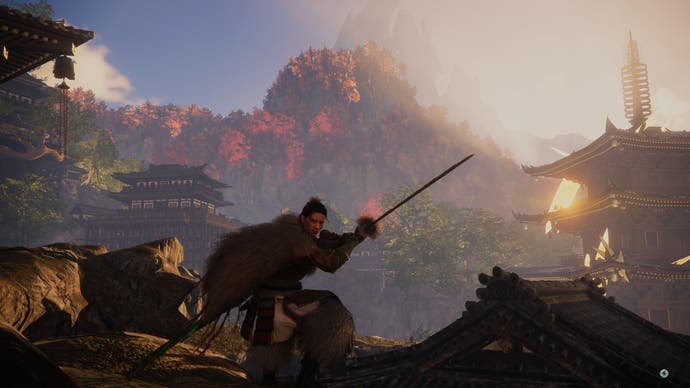

It's a lot to take in, but Wild Hearts is patient about introducing its idiosyncrasies, and as you grow more accustomed to its interlocking systems of combat – the construction, the real-time resource management, the pattern recognition, and the good-old hitting stuff with a pointy thing – the whole thing starts to sing, building into a joyous ballet of barely restrained chaos that's fast, slick, and thrilling in Wild Hearts' own unique way. And, needless to say, online co-op – wisely restricted to three players to keep things readable – is also a hoot as giant creatures rampage, massive Karakuri traps blink into whirling existence, hunters ping and rocket through space, and barely ordered pandemonium unfurls.
Complaints, beyond some inevitable fatigue brought on by its close proximity to Monster Hunter (both in terms of its basic design and release window), are surprisingly few, but I do worry about the impact of Wild Hearts' relatively limited monster pool. While elemental variants often bring interesting new twists to familiar fights, and higher-level variants demand far more exacting strategies through their increased aggression and tweaked timings, you're still only looking at a total of 21 unique monsters if you include elemental variants - less than half of Monster Hunter Rise's base game. It makes it difficult to gauge just how much staying power Wild Hearts will ultimately have, even with the promise of more monsters to come after launch.

And finally, it'd be remiss not to mention performance, which on my review PC - well above EA's recommended spec – was plagued by troubling graphical issues like constant stuttering and sluggish pop-in, regardless of settings. Reports from early access players suggest these may be widespread across all platforms, and Omega Force has pledged to improve the situation, starting with a PC CPU bottleneck patch next week. Still, it's something to keep in mind right now, although I personally found performance tolerable if far from ideal.
Ultimately though, what Omega Force has created in Wild Hearts is a game of beautifully interweaving systems that, while undoubtedly familiar, is smart and refreshing in ways I wasn't expecting. Early on, I couldn't help but wonder who all this was all for, but 50 hours in, it's clear there's plenty for everyone to enjoy. Wild Hearts is approachable in a way I think a lot of people who've bounced off Monster Hunter are going to appreciate, and for those like me with literally thousands of hours of Capcom's series under their belts, it offers a thoughtful, incredibly energising twist on a beloved formula. I sincerely hope this isn't the last we'll see of Wild Hearts, and that Omega Force is given the opportunity to develop and refine the series across many years to come - because this debut outing is a monstrous amount of fun.
